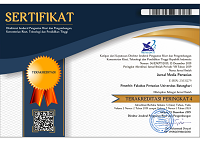Komposisi Gulma Pada Perkebunan Kelapa Sawit (Elaeis guineensis Jacq.) Sebelum dan Setelah Dilakukan Pengendalian Secara Mekanik dan Kimia
Abstract
Keywords
Full Text:
PDFReferences
Government of New South Wales. 2018. Praxelis (Praxelis clematidea). https://weeds.dpi.nsw.gov.au/Weed/Praxelis. (Diakses 23 November 2022).
Khamare Y, C Marble, S Steed & N Boyd. 2020. Biology and management of Praxelis (Praxelis clematidea) in ornamental crop production. IFAS Extension. [Internet] https: //edis.ifas.ufl.edu. (Diakses 23 November 2022).
MacDougal AS & R Turkington. 2007. Does the type of distribance matter when restoring disturbance-dependent grasslands?. Restoration Ecology 15(2): 263-272.
Mas’ud H. 2009. Komposisi dan efisiensi pengendalian gulma pada pertanaman kedelai dengan penggunaan bokashi. Jurnal ilmu-ilmu pertanian 16(2): 118-123.
Mawandha HG, A Mu’in & M Febri. 2022. Kajian pengendalian gulma Ottochloa nodosa di perkebunan kelapa sawit. Jurnal Agroteknologi 6(1): 70-79.
Moenandir J. 1993. Ilmu Gulma dalam Sistem Pertanian. PT Raja Grafindo Persada, Jakarta.
Mukarromah L, DRJ Sembodo & Sugiatno. 2014. Herbisida glifosat terhadap gulma di lahan tanaman kelapa sawit (Elaeis guineensis Jacq.) belum menghasilkan. Jurnal Agrotek Tropika 2(3): 369-374.
Nora S & CD Mual. 2018. Budidaya Tanaman Kelapa Sawit. Kementerian Pertanian, Jakarta.
Ochuodho JO & AT Modi. 2005. Temperature and light requirements for the germination of Cleome gynandra seed. South African Journal of Plant and Soil 22(1): 49-54.
Oktavia K, H Pujisiswanto, R Evizal & H Susanto. 2019. Pengaruh aplikasi glifosat terhadap efikasi dan komposisi gulma pertanaman kelapa sawit tanaman menghasilkan muda. Jurnal Agro Industri Perkebunan 7(1): 1-9.
Paiman. 2020. Gulma Tanaman Pangan. UPY Press. Yogyakarta.
Palijama, W, J Riry & AY Wattimena. Komunitas gulma pada pertanaman pala (Myristica fragrans H.) belum menghasilkan dan menghasilkan di Desa Hutumuri Kota Ambon. Jurnal Agrologia 1(2): 134-142.
Purba E. 2009. Keanekaragaman herbisida dalam pengendalian gulma mengatasi populasi gulma resisten dan toleran herbisida. Pidato Pengukuhan Jabatan Guru Besar Tetap. Universitas Sumatera Utara, Medan.
Rao VS. 2017. Principles of Weed Science. Second Edition. CRC Press, USA.
Ratna Y, EI Swari & A Firmansyah. 2022. Pertumbuhan gulma alang-alang (I. cylindrica) pada berbagai kondisi kepadatan setelah pemotongan di Petrochina International Jabung LTD. Jurnal Media Pertanian 7(1): 50-60.
Rolando CA, BR Baillie, DG Thompson & KM Little. 2017. The risk associated with glyphosate-based herbicide use in planted forests. Forests 8(6) : 1-26.
Sastroutomo SS. 1990. Ekologi Gulma. Gramedia Pustaka Umum, Jakarta.
Sembodo DRJ. 2010. Gulma dan Pengelolaanya. Graha Ilmu. Yogyakarta.
Setyawati T, S Narulita, IP Bahri & GT Raharjo (Editor : T Partomihardjo, S Tjitrosoedirdjo & Sunaryo). 2015. A Guide Book to Invasive Plant Species in Indonesia. Research, Development and Innovation Agency, Ministry of Environment and Forestry. Indonesia.
Sudrajat. 2020. Kelapa Sawit: Prospek Pengembangan dan peningkatan Produktivitas. IPB Press, Bogor.
Suryana, MA Chozin & D Guntoro. 2019. Identifikasi spesies tanaman penutup tanah pada perkebunan kelapa sawit menghasilkan. Jurnal Agronomi Indonesia, 47(3): 305-311.
Tjitrosoedirdjo S, H Utomo & J Wiroatmodjo. 1984. Pengelolaan Gulma di Perkebunan. PT. Gramedia, Jakarta.
Tjitrosoedirdjo S, SS Tjitrosoedirdjo & T Setyawati. 2016. Tumbuhan Invasif dan Pendekatan Pengelolaanya. SEAMEO BIOTROP, Bogor.
Tjokrowardojo AS & A Djauhariya. 2011. Gulma dan Pengendaliannya pada Budidaya Tanaman Nilam. Balai Penelitian Tanaman Obat dan Aromatik, Bogor.
Triharso. 2010. Dasar-dasar Perlindungan Tanaman. Gadjah Mada University Press, Yogyakarta.
Umiyati D & Kurniadie. 2016. Pergeseran populasi gulma pada olah tanah dan pengendalian gulma yang berbeda pada tanaman kedelai. Jurnal Kultivasi 15(3): 150-153.
Zimdahl LR. 2007. Fundamentals of Weed Science. British Library Cataloguing-in-Publication Data, London.
DOI: http://dx.doi.org/10.33087/jagro.v10i2.293
Refbacks
- There are currently no refbacks.

This work is licensed under a Creative Commons Attribution-ShareAlike 4.0 International License.
Jurnal Media Pertanian Published by Fakultas Pertanian Universitas Batanghari |



